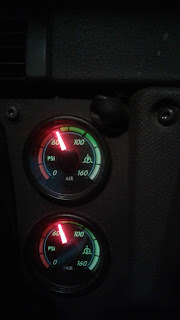Dispatched on a load scheduled to pickup at 4 p.m.
"Call the broker" they said, so I called the broker.
"Pick it up noon," said the broker,
So I started my 14-hour clock and drove to the shipper leaving my parking spot at the truck stop where I had access to food drinks a restroom facility Etc.
" You are early," said the shipper,
" That load doesn't pick up until 4 p.m."
"Oh," I replied "The broker told me to pick it up at noon instead, I assumed that she had cleared that with you."
"Nope."
" Well," I asked in my nicest voice "Do you think there's any way possible I might get loaded a little early?"
" Anything is possible," he said with a smirk.
At approximately 2:30 I was backed into a door, about an hour later I felt them start loading my truck.
at 4:30 the broker called me back.
"Hey hon," she said in her I'm-trying-to-be-all-nice-and-friendly southern accent,
"Did they get you all taken care of over there?"
" Not yet," I replied "I'm still sitting here in the dock waiting to be loaded."
" Oh my goodness that's too bad," she said.
" Sometimes they'll load people early so I like to send Drivers over there early just in case. Most of the time they don't but sometimes they do."
"The most frustrating part," I remarked "Is that I had to start my 14-hour clock 4 hours early and now I've just been sitting here burning up my clock for nothing."
" Oh darling that's too bad," she said, again with those syrupy overtones of southern hospitality, but lacking the genuine sincerity one often hears.
" I just don't know how you guys do it out there, I know I could never do it."
Well, my patient reader who has read through this entire conversation hoping to find a point somewhere , I'll tell you how we do it.
We sit here on the dock waiting to be loaded, and while we wait we silently curse under our breath.
We curse the load planner who felt it was appropriate to have the driver contact the broker, instead of contacting the broker themselves and getting the needed information and passing it along to us.
We curse the brokers who demand that drivers call them directly and we curse the company that tolerates those demands.
We curse the situation because if the company had directed us to come here at noon, and we had to sit this long, we would get paid for our time, but since it was the broker who made that demand, and since the original work order still says 4 p.m., our time is volunteer time and we sit here for free.
We curse Brokers that have no vested interest in drivers but still end up in a position of telling them what to do.
We curse Brokers that truly DO NOT know how we do it out here, and who truly COULD NOT ever do it.
We curse everyone from the Federal Motor Carrier Safety Administration to the National Transportation Safety Council, to the load planners and dispatchers and brokers, and everyone else who has never been inside a truck, never done this job, doesn't have the first clue about how to do this job, and yet somehow managed to end up in a position of authority where their job is to tell us how to do our job.
And then we finish cursing and because we need the money, because we have bills to pay, because we have homes and families to support, and because this is what we do, we do our best to get the load there safely, legally and on time, because in the end that's all anybody really cares about.
The broker doesn't care if I sat here all day without pay.
The dispatcher doesn't care, the load planner doesn't care, the shipper doesn't care and the receiver doesn't care.
When Billy Bob Consumer and Susie Q. Housewife go to the grocery store for their milk and bread and toilet paper, they don't care how long I sat at the shipper without any pay. All they care about is whether or not there's milk and bread and toilet paper on the shelf.
When people do their back-to-school shopping or when they put the gas in their car or when they BUY a new car, or when they buy anything else for that matter, they don't care about how the manufacturer treated the truck driver or about how the intermediate warehouse treated the truck driver or about how the retailer treated the truck driver.
They don't even care about how the carrier or the load planner or the dispatcher or the broker treated the truck driver. All they care about is whether or not their consumer goods are there and available for them when they need them.
And because of about 3.5 million men and women out here on the road just like me doing what we do, the goods ARE there when you need them
Kind of funny when you think about it; How folks will fight about a statue because it represents how someone was treated a long time ago, but they don't give a second thought to how people are treated today.
I would propose that we erect a 53-foot, 18 wheel Monument to the American truck driver, but I imagine most people would just assume it was sitting there waiting to be loaded and wouldn't give it another thought
For my few friends who like me enough to have read all the way through this, you guys are the best friends in the whole world thank you for putting up with me




































